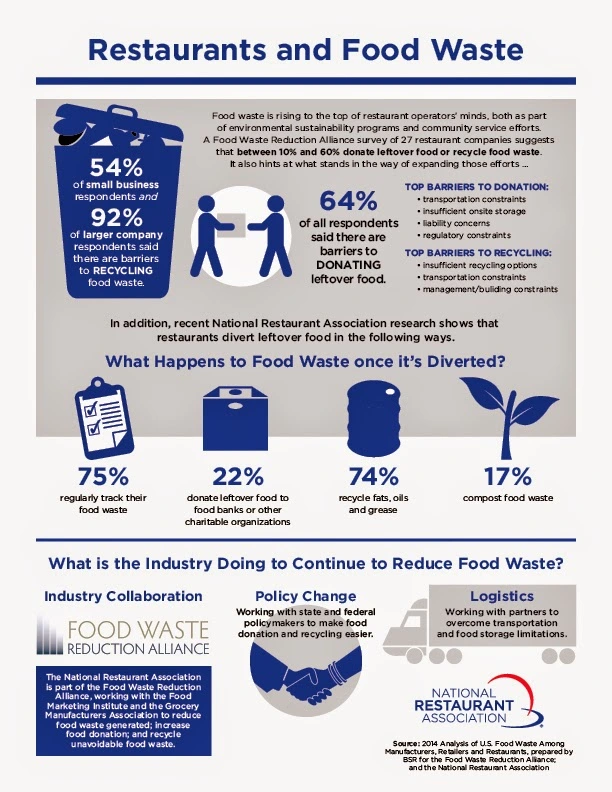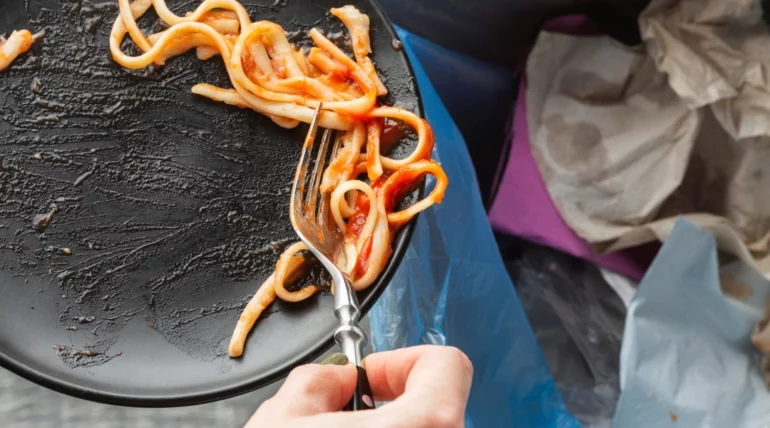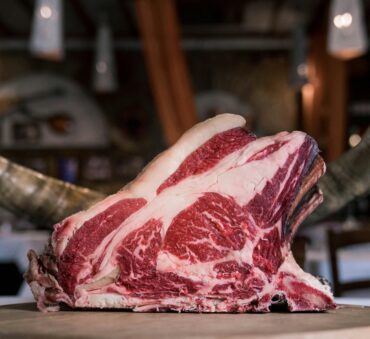As delicious meals are crafted and served, behind the scenes, an unsavory truth unfolds.
From fast-food franchises to high-end dining establishments, food waste has infiltrated every corner of the restaurant industry, becoming a silent scourge that weighs heavily on our planet and pockets. As we dine, serve, or cook, we’re often oblivious to the mountain of waste that accumulates in the background – the half-eaten meals, the overstocked pantries, the unsold daily specials. But the problem isn’t invisible, and the solutions, while complex, are within our grasp if we choose to make a concerted effort.
In this article, we delve into the intricacies of food waste in restaurants and explore the strategies for managing it effectively.
The scale and impact of food waste in the American restaurant industry
The food waste issue in U.S. restaurants is substantial. To truly grasp the magnitude of this problem, let’s take a look at some startling statistics:
- Scale of Waste: Every year, U.S. restaurants generate approximately 22 to 33 billion pounds of food waste.
- Financial Impact: This discarded food represents about $25 billion lost each year for the restaurant industry.
- Environmental Impact: If food waste were a country, it would be the third-largest emitter of greenhouse gases, following only the U.S. and China.
- Pre-consumer Waste: Around 4-10% of food purchased by restaurants becomes kitchen loss, both edible and inedible, before reaching the consumer.
- Post-consumer Waste: After serving, about 17% of restaurant meals are not eaten and most likely end up as waste.
- Portion Sizes: Large portion sizes contribute to waste; the average restaurant meal today is more than four times larger than in the 1950s.
Food waste in fast-food restaurants vs. traditional restaurants in the U.S.
The food service industry is vast and diverse, with different types of establishments contributing to food waste in different ways. While both fast-food and traditional restaurants contribute to the food waste issue, they do so in somewhat distinct manners due to their diverging operational structures and customer behaviors.
1. Fast-Food Restaurants
Amount of Waste: Fast-food restaurants tend to generate substantial food waste. This is largely due to their operating model, which requires maintaining a ready supply of fast-to-serve foods. However, predicting customer demand can be challenging, leading to overproduction and, subsequently, waste.
Types of Waste: The types of waste produced in fast-food restaurants are often linked to overprepared foods that aren’t purchased, like burgers, fries, and other menu items made in anticipation of high demand. Other significant waste includes packaging material due to the take-out nature of many fast-food purchases.
2. Traditional Restaurants
Amount of Waste: Traditional, sit-down restaurants also generate a significant amount of food waste. Portion sizes tend to be larger in these establishments, leading to more plate waste – food that customers leave uneaten. Additionally, in an effort to provide varied and fresh menu options, these restaurants may end up with spoilage waste.
Types of Waste: Traditional restaurants’ waste often comes from plate waste, overstock, and spoilage. Plate waste includes unfinished meals left by customers. Overstock and spoilage result from purchasing and preparing more ingredients than are used, especially for restaurants that pride themselves on fresh ingredients and daily specials.
The environmental and financial impact of restaurant food waste in America
Food waste has profound environmental implications, contributing to about 8% of global greenhouse gas emissions. When we waste food, we also waste all the resources—like water, energy, and raw materials—that went into producing, processing, transporting, and preparing it.
From a financial standpoint, food waste represents a considerable loss of money for restaurants. According to the National Restaurant Association, on average, commercial kitchens typically waste 4% to 10% of the food they purchase.
U.S. legal regulations and Implications for restaurant food waste disposal
In the United States, the disposal of food waste from restaurants is subject to a variety of regulations, both at the federal and state levels. It’s important for restaurants to understand and comply with these regulations to avoid potential legal and financial repercussions.
Federal Regulations
At the federal level, the U.S. Environmental Protection Agency (EPA) encourages food waste recycling through its Food Recovery Hierarchy. This is a prioritized approach that suggests steps to prevent and divert wasted food. The recommended steps, in order of priority, include:
- Source reduction (reduce the volume of surplus food generated)
- Feed hungry people (donate extra food to food banks, shelters, and soup kitchens)
- Feed animals (divert food scraps to animal feed)
- Industrial uses (render fats, oils, dispose of grease and recycle other food scraps into biofuel and other bio-based products)
- Composting (turn food scraps into a nutrient-rich soil amendment)
- Landfill/Incineration (last resort for managing food waste)
Although this hierarchy doesn’t carry legal mandates, it influences state and local policies on food waste and serves as a guideline for best practices in food waste management.
State and Local Regulations
State and local regulations can be more specific and stringent than federal regulations. For example, states like California, Massachusetts, and Vermont have implemented bans on the disposal of organic waste, including food waste, in landfills. These bans typically apply to establishments that generate a certain amount of organic waste per week, which includes many restaurants.
These laws aim to divert food waste to more beneficial uses, such as donations to food banks or composting. Non-compliance can result in substantial fines, and restaurants are thus incentivized to develop robust food waste management strategies.
Why Do Restaurants Waste Food?
The reasons behind the food waste issue in restaurants are multifaceted, stemming from operational routines to external factors, such as:
Over-Preparation of Food
A restaurant’s core mission is to serve its customers well, and that includes providing them with a wide array of dishes without delay. This expectation often results in overpreparation of food. Chefs frequently prepare substantial amounts of food ahead of time to accommodate anticipated demand, which can lead to waste if the demand doesn’t match the preparation.
Inefficient Inventory and Storage Management
Managing a restaurant’s inventory is a complex task. It requires a delicate balance to have enough fresh ingredients on hand to prepare various menu items while avoiding overstocking perishable items that may spoil. If inventory isn’t managed effectively, or if there’s inadequate storage, food items can go bad before they’re used, contributing to food waste.
Large Portion Sizes
In a bid to provide value for money or to stand out from competitors, many restaurants serve large portion sizes. While this may be attractive to some customers, it often results in increased plate waste as customers leave behind what they can’t finish. What’s more, the norms of restaurant culture often discourage customers from asking for doggy bags.
Difficulty Forecasting Customer Demand
Predicting demand is one of the biggest challenges restaurants face. It’s not easy to accurately predict how many customers there will be each day and what they’ll order. This uncertainty often leads to over-purchasing and over-preparing food, both of which result in food waste if the expected demand doesn’t materialize.
Food Presentation and Aesthetics
In many restaurants, the presentation of dishes is just as important as taste. Chefs often carve vegetables, meats, and other ingredients into specific shapes and sizes to create visually appealing dishes. This process can result in a significant amount of food being discarded.
Miscommunication in the Kitchen
A kitchen is a high-stress, fast-paced environment. In such conditions, miscommunication can easily occur, leading to mistakes like cooking the wrong dish or using the wrong ingredients. These errors result in food that can’t be served to customers and therefore goes to waste.

Common types of food waste in restaurants
- Spoilage: food that becomes unfit for consumption before it can be served to the customer.
- Preparation Waste: Food that is discarded during the cooking or preparation process. Examples include peels, trimmings, and other food parts.
- Plate Waste: food left uneaten by customers, which is subsequently discarded.
Solutions and Strategies for Reducing Food Waste in Restaurants
Menu Planning and Portion Control
Careful menu planning and portion control can significantly reduce food waste. By aligning the menu offerings with customer demand, serving appropriate portions, and offering flexible portion sizes, restaurants can cater to different appetites. This also helps customers make waste-conscious decisions and avoid both over-preparation and plate waste.
Efficient Inventory Management
Smart inventory management not only saves money but also reduces food wastage. This ensures that they neither over-purchase nor under-utilize ingredients, thereby minimizing spoilage. Regular stock takes, using a first-in-first-out system, and using a restaurant food waste log can all contribute to lowering the total amount of food waste. There are many other examples of food waste technology that can be very useful.
Training Staff and Raising Awareness
Providing training and fostering a culture that values food. When staff are aware of the impact of food waste and equipped with strategies to minimize it, they become active participants in the restaurant’s waste reduction efforts.
Establishing Partnerships with Food Banks and Charities
By partnering with local food banks and charities like Feeding America and Meals on Wheels America, restaurants can donate surplus food. This not only helps reduce waste but also benefits local communities.
Collaborating with Waste Management Companies
Restaurants can effectively curb their carbon footprint and minimize landfill waste by partnering with waste management companies. Such partnerships can ensure sustainable waste disposal practices, diverting waste away from landfills and towards more environmentally-friendly alternatives such as composting or conversion into renewable energy through process of anaerobic digestion. As a dedicated player in the waste management sector, we at Shapiro offer tailored solutions to help restaurants navigate their food waste challenges and march toward a sustainable future.
The Benefits of Reducing Food Waste in Restaurants
Cutting down on food waste isn’t just a moral duty—it also brings about tangible benefits for restaurants:
Financial savings and cost benefits
Effective waste management can translate into significant financial savings. Reduced purchasing costs, decreased waste disposal fees, and tax benefits can all contribute to a healthier bottom line.
Environmental contributions
Every piece of food saved means fewer resources wasted and less greenhouse gas emissions. It’s a direct contribution to the fight against climate change.
Enhancing the restaurant’s reputation and social responsibility
Restaurants that take steps to reduce their food waste can boost their reputation and demonstrate their commitment to social responsibility. This can help attract customers who value sustainability and social consciousness.
Conclusion
For restaurants, managing food waste is not just about compliance or cost savings—it’s about embracing a holistic approach to sustainability, one that considers the environmental, economic, and social impacts of their operations. It’s about understanding that every plate of food has a journey, and we have the power to influence where that journey ends.
The issue of food waste in restaurants is not just a topic of discussion; it’s a call to action, a challenge we must rise to meet. Because the future of food isn’t just about what we eat—it’s about what we waste.
Are you prepared to contribute to a change? Reach out to Shapiro today.
Frequently Asked Questions
Restaurants contribute to 11.4 million tons of food waste each year in the U.S. alone, which results in around 7.3 million tons from full-service restaurants and around 4.1 million tons from limited-service restaurants.
Restaurants can track food waste by keeping a waste log, using food waste tracking apps, or partnering with waste management companies.
The exact percentage can, of course, vary depending on the restaurant, but studies suggest that restaurants can waste anywhere from 4% to 10% of the food they purchase.
To calculate the average food waste percentage, divide the weight/volume of wasted food by the total weight/volume of food purchased and then by 100.
Avoiding food waste can be achieved through effective menu planning, inventory management, staff training, and reducing portion sizes.
Exact figures can vary, but due to their operational model, fast food restaurants typically generate more food waste compared to traditional restaurants.
Restaurants can reduce food waste by implementing a variety of strategies. These include:
Efficient menu planning to reduce overproduction.
Adopting effective inventory management practices to prevent spoilage.
Training staff to understand the importance of food waste reduction.
Establishing partnerships with local food banks, charities, or waste management companies like Shapiro Enterprises to responsibly dispose of or repurpose excess food.
Baily Ramsey, an accomplished marketing specialist, brings a unique blend of anthropological insight and marketing finesse to the digital landscape. Specializing in educational content creation, she creates content for various industries, with a particular interest in environmental initiatives.



